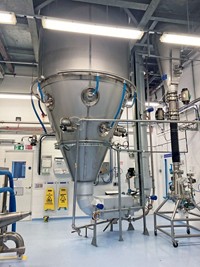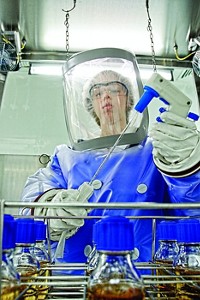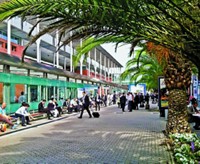Advertisement
Grab your lab coat. Let's get started
Welcome!
Welcome!
Create an account below to get 6 C&EN articles per month, receive newsletters and more - all free.
It seems this is your first time logging in online. Please enter the following information to continue.
As an ACS member you automatically get access to this site. All we need is few more details to create your reading experience.
Not you? Sign in with a different account.
Not you? Sign in with a different account.
ERROR 1
ERROR 1
ERROR 2
ERROR 2
ERROR 2
ERROR 2
ERROR 2
Password and Confirm password must match.
If you have an ACS member number, please enter it here so we can link this account to your membership. (optional)
ERROR 2
ACS values your privacy. By submitting your information, you are gaining access to C&EN and subscribing to our weekly newsletter. We use the information you provide to make your reading experience better, and we will never sell your data to third party members.
Business
Ready For Five More
Sigma-Aldrich’s fine chemicals business sets its sights on the next five years of operation
by Ann M. Thayer
June 21, 2010
| A version of this story appeared in
Volume 88, Issue 25

Just over five years ago, research chemicals provider Sigma-Aldrich launched a fine chemicals business under the SAFC brand. Through a series of business and technology acquisitions, coupled with steady internal investment, the business tripled in size and today has about $600 million in annual sales. From its start as a custom manufacturer of pharmaceutical chemicals, SAFC has also become a major supplier of cell-culture products for biomanufacturing and advanced materials for electronics.
“We are a ‘fine molecules’ supplier, meaning that we are in both small and large molecules, and not only in chemistry but biology, materials science, and analytical chemistry, as well,” SAFC President Gilles A. Cottier explained at a recent briefing for reporters. SAFC’s goal is to help customers make products by providing science-based tools and high-tech manufacturing. As the business strategizes for its next five years, this goal “translates into what we are and what we want to be,” he added.
SAFC’s desire for differentiated technical capabilities is apparent in its approach to synthesizing highly potent active pharmaceutical ingredients (APIs). These operations originated in the 2004 acquisition of Tetrionics, a small firm with annual sales of about $15 million. Tetrionics’ chemistry was developed at the University of Wisconsin, Madison, and used to make paricalcitol, a vitamin D analog that is the API in Abbott Laboratories’ parathyroid drug Zemplar.
By January 2005, SAFC had broken ground on its first expansion, spending $12 million to double capacity of highly potent compounds in the former Tetrionics plant at the University Research Park, in Madison. Within two years, it added pilot-plant and kilogram-scale lab capacity at the facility and added suites in St. Louis for conjugating potent compounds to antibodies.
All told, SAFC has invested more than $75 million in the high-potency area. Included in the total is $29 million to expand fermentation-derived potent API capacity in Israel, which is due to come onstream in the third quarter. And in April, SAFC opened a $30 million, 51,000-sq-ft highly potent API facility near Madison, in Verona, Wis.
SAFC still makes the vitamin D analog and 15 other commercial products at its Madison site. The expectation is that large-scale projects will soon populate the Verona facility, which was designed to support customers’ needs for drugs that are on the market or in Phase III clinical trials. In two large-scale suites, reactors can accommodate batches in volumes of up to 4,000 L.
Roughly one-third of SAFC’s API business is related to high-potency manufacturing, said David Feldker, vice president of SAFC Pharma, who maintains that the capacity buildup, although rapid, wasn’t rash. “We have to be very judicious of what we are building and when, and that is mostly driven by customer timing on demand,” he said. The market for highly potent compounds should continue to experience double-digit growth, according to SAFC.
Indeed, double-digit growth in many target markets meant that SAFC had no reason to alter its strategy, despite the economic downturn, Cottier told C&EN. This strategy included the Verona and Israel expansions and a $12 million investment in viral manufacturing in Carlsbad, Calif., that added commercial-scale capability to make biologics, vaccines, and gene therapy products.
That isn’t to say the company didn’t feel an impact from the recession. “Like every company, we took a look at our cost structure and discretionary spending and may have accelerated some decisions, but these were not cost-containment exercises only,” he said. For example, SAFC consolidated production of dry-powder media in Lenexa, Kan., but it is spending more than $6 million to expand the site into a “center of excellence.” SAFC recently announced it will expand production of reagents for liquid cell culture in St. Louis and Scotland.
Cottier pointed out that the fine chemicals industry underestimated the negative impact of some market trends, such as the decline in generalized outsourcing and the extent of the economic downturn. He believes that geographic, technological, and customer diversification helped SAFC continue to grow in 2009. “If you only bring pots and kettles, or undifferentiated capacity, and try to compete only on price, you are not going to succeed in this market,” he said.
In a June 5 report, analysts at the investment advisory firm Standard & Poor’s said they expect 8% organic growth for the SAFC business in 2010. Factors at play include a relatively stable life sciences market and improving demand trends from customers.
Looking ahead, Cottier said SAFC won’t seek to play in every segment of the $60 billion-per-year fine chemicals market. Instead, he anticipates expanding in faster growing applications and geographic regions. Despite its past history, “we are not going to be on an acquisition spree, although we will look at opportunities as they come along,” he said. “We have to make sure that what we have invested in ourselves pays off.”







Join the conversation
Contact the reporter
Submit a Letter to the Editor for publication
Engage with us on Twitter